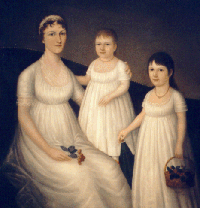
This is impossible to determine, as there were many folk artists and artisans brought to the new world on slave ships. Joshua Johnston (1765-1830), Otto Reinhold Jacobi (1812-1901), Patrick Reason (1817-1856), William H. Simpson (1818-1872), and Robert Scott Duncanson (1821-1872) represent some of the names of the early trailblazers who were the unusual combination of black, American, and artist. A review of their work suggests that these vanguards did not focus on the issues surrounding their racial acceptance in society; but rather followed personal or business interests such as Duncanson’s extensive mural work resulting from his classical education in Paris. Robert Scott Duncanson, considered by some art historians as the first black man to earn his living as an artist, was a painter of both Hudson River landscapes and floral still lifes. Joshua Johnston, “ the first American artist of African descent to create a sizeable body of work of high quality” according to Romare Bearden’s Six Black American Artists, was listed in a Baltimore directory from 1796 to 1824 as a portraitist. Edward Mitchell Bannister (1828-1901) was a well-known landscape and genre painter from Providence, Rhode Island. Although he was the first Black American artist to win a national art prize, a first-place at the Philadelphia Exposition in 1876, he was denied admission into the hall to accept the award because of his race. Specializing in making bird’s-eye views of California and Nevada towns, Grafton Tyler Brown (1841-1918) was the first recognized Black American artist in the American West. Henry Ossawa Tanner (1859-1937), known for religious and genre paintings, was the first black artist to earn an international reputation. Although Thomas Eakins encouraged him while a student at the Pennsylvania Academy of Fine Arts, Tanner experienced much prejudice in Philadelphia, and chose to expatriate to Paris.
